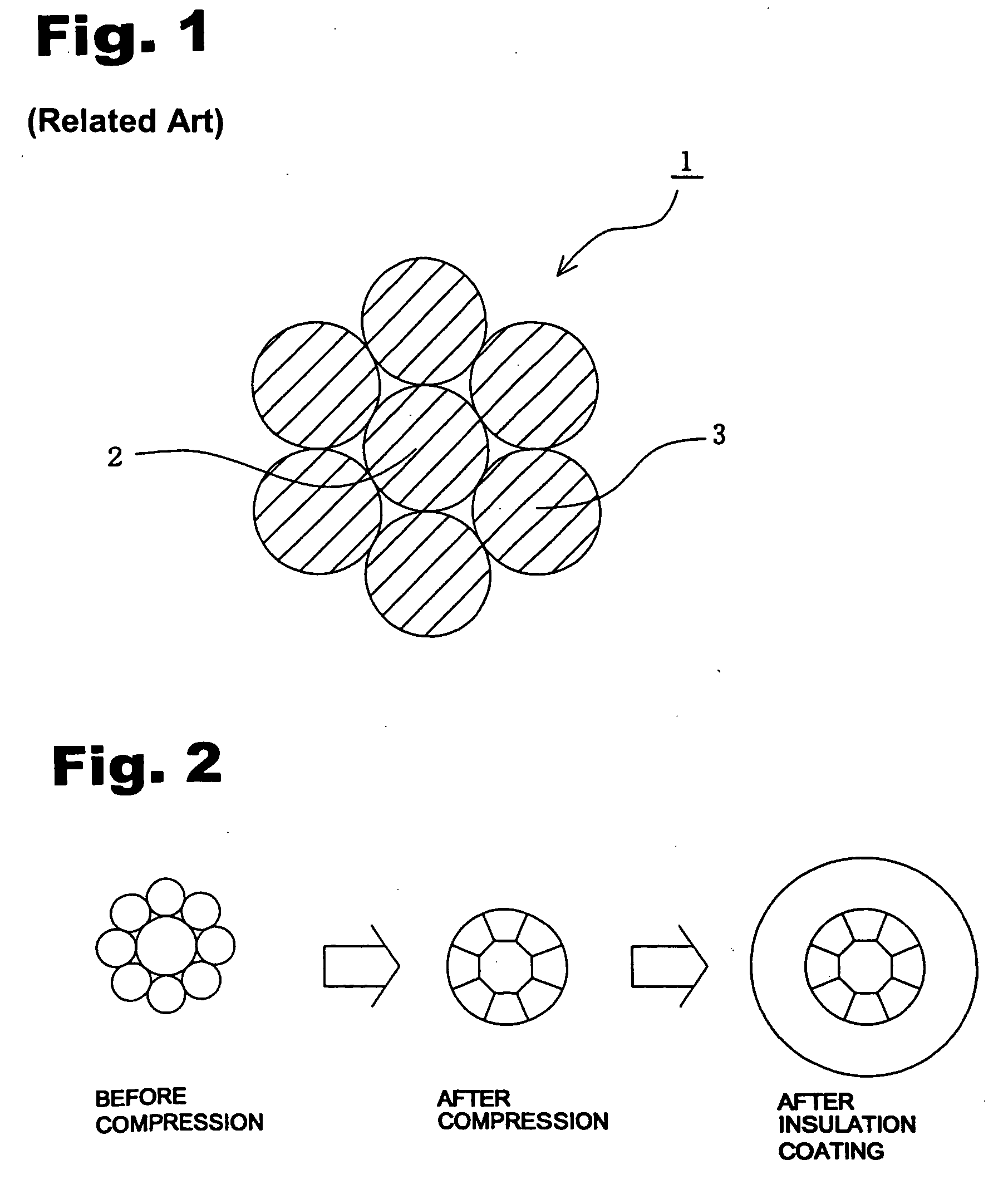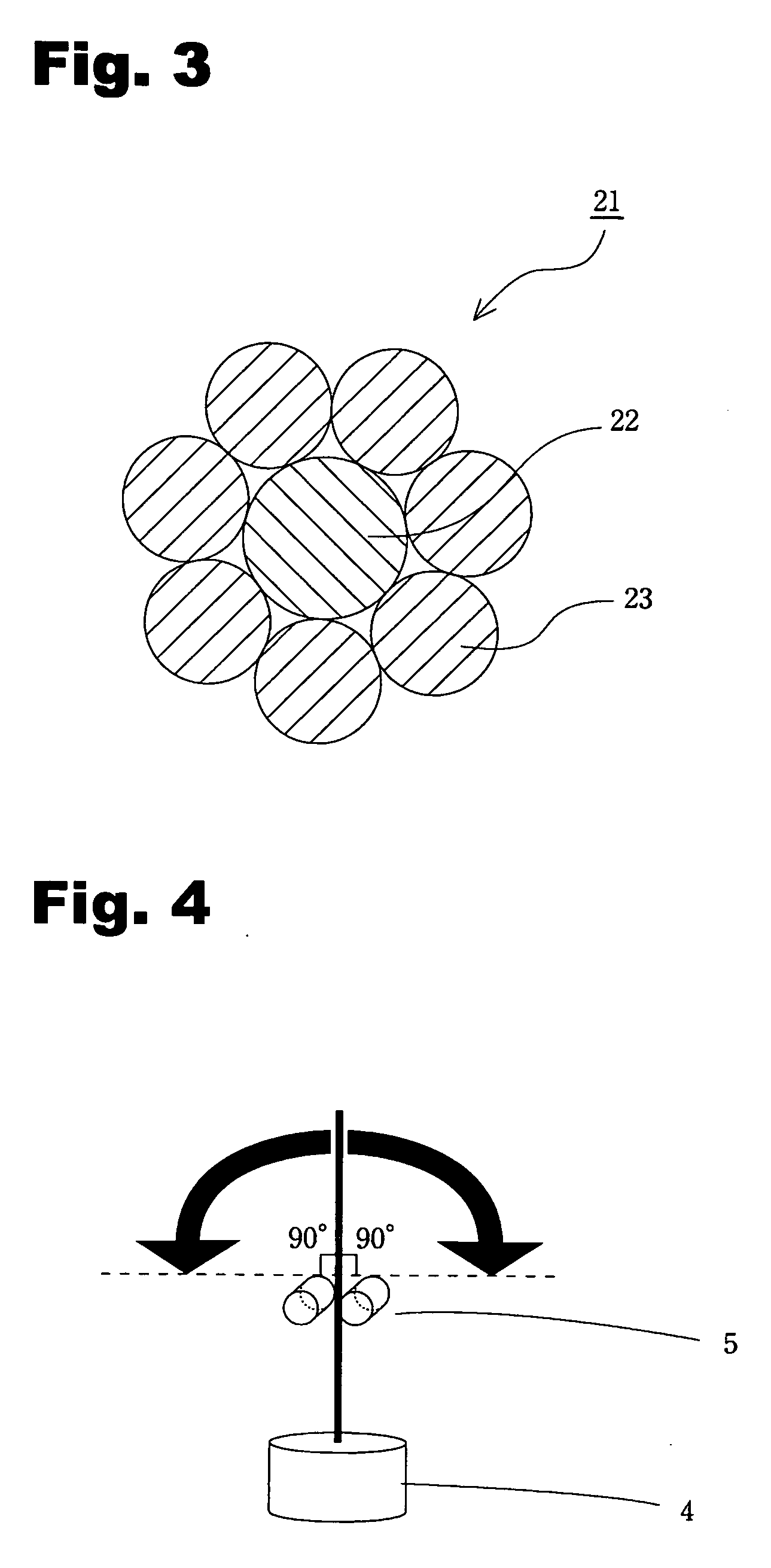Electric wire for automobile
a technology for electric wires and automobiles, applied in the direction of electrical devices, non-insulated conductors, conductors, etc., can solve the problem of ignoring the demand for a smaller diameter
- Summary
- Abstract
- Description
- Claims
- Application Information
AI Technical Summary
Benefits of technology
Problems solved by technology
Method used
Image
Examples
example 1
[0061] SUS 304 having the cross sectional area of 0.0314 mm and the tensile fracture strength of 957 MPa was used as a central element wire before compression, and pure copper having the cross sectional area of 0.1321 mm2 and the tensile fracture strength of 240 MPa was used as peripheral element wires before compression. Seven such peripheral element wires were arranged in a single circle in tight adherence with each other around the central element wire, they were compressed using dies and then coated by extrusion with an insulation coating material which was a halogen-free material (olefin based), whereby the electric wire for automobile according to the invention was obtained.
[0062] The cross sectional area of the central element wire of thus obtained electric wire was 0.0274 mm2, the cross sectional area of the conductor was 0.14 mm2, and the ratio C of the cross sectional area of the central element wire to the cross sectional area of the conductor was 19.6%. The tensile brea...
example 2
[0063] SUS 304 having the cross sectional area of 0.0398 mm2, and the tensile fracture strength of 949 MPa was used as a central element wire before compression. Pure copper having the cross sectional area of 0.1231 mm2, and the tensile fracture strength of 245 MPa was used as peripheral element wires before compression. Eight such peripheral element wires were arranged in a single circle in tight adherence with each other around the central element wire. They were compressed using dies and then coated by extrusion with an insulation coating material, which was a halogen-free material (olefin based), whereby the electric wire for automobile according to the invention was obtained. The cross sectional area of the central element of thus obtained electric wire was 0.0343 mm2, the cross sectional area of the conductor was 0.14 mm2, and the ratio C of the cross sectional area of the central element wire to the cross sectional area of the conductor was 24.5%. The tensile breaking load wa...
example 3
[0076] SUS 304 having the cross sectional area of 0.0314 mm2, and the tensile fracture strength of 957 MPa was used as a central element wire before compression. Pure copper having the cross sectional area of 0.1321 mm2, and the tensile fracture strength of 240 MPa was used as peripheral element wires before compression. Seven such peripheral element wires were arranged in a single circle in tight adherence with each other around the central element wire. They were compressed at the compression rate of 10% using dies, thereby obtaining a conductor having the cross sectional area of 0.14 mm2. Then, insulation coating was disposed by extrusion using a halogen-free material (olefin based) as a coating material, whereby the electric wire for automobile according to the invention was obtained. The tensile breaking load of thus fabricated electric wire was 68 N, the breaking load of the conductor was 59 N, and the impact breaking load was 11 N.
PUM
| Property | Measurement | Unit |
|---|---|---|
| area | aaaaa | aaaaa |
| area | aaaaa | aaaaa |
| area | aaaaa | aaaaa |
Abstract
Description
Claims
Application Information
 Login to View More
Login to View More - R&D
- Intellectual Property
- Life Sciences
- Materials
- Tech Scout
- Unparalleled Data Quality
- Higher Quality Content
- 60% Fewer Hallucinations
Browse by: Latest US Patents, China's latest patents, Technical Efficacy Thesaurus, Application Domain, Technology Topic, Popular Technical Reports.
© 2025 PatSnap. All rights reserved.Legal|Privacy policy|Modern Slavery Act Transparency Statement|Sitemap|About US| Contact US: help@patsnap.com



